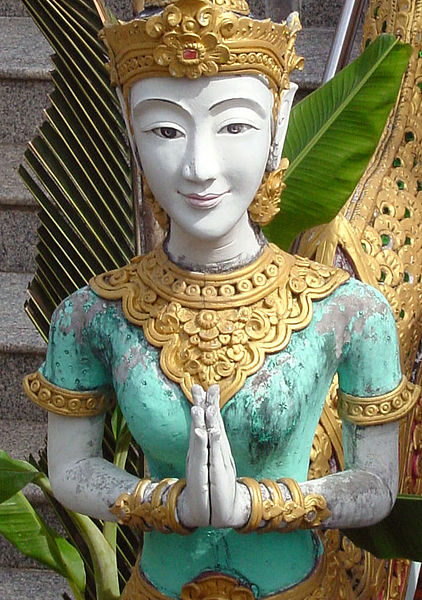I sit before practice, legs folded into half lotus—not full padmasana yet, I am not warm enough.
I settle in, feeling my hips begin to open, my vertebrae fall into place, stacking one atop the other in their ancient order. My face softens as I gaze at my little shrine—a stone Buddha draped with malas and seated on a hand carved wooden stool.
Behind him, a colorful tapestry of Lakshmi, goddess of abundance, who sits among smiling elephants decorated with sequins and bright thread.
I tip my chin slightly downward and place my palms together in Anjali Mudra—prayer position. I close my eyes and give thanks.
The moment my hands come together in prayer, the entire energy of my body, mind and spirit shifts. It is a timeless, powerful– yet humble– gesture. Palm on palm, I can feel my own essential self; I am present, I am real and alive.
In prayer, I tap into my own beating heart first, and then into all the beating hearts of all the souls in creatures great and small, animate and inanimate, who have ever existed and who will ever exist.
Similar gestures with the same impact have existed in every culture. They are the language of the hands—a primal, connective thing.
In yoga, we call these gestures “mudras,” and there are many ways we can learn to position our hands to help manifest a state of mind or an energy we desire for our lives. There is literally a mudra for every conceivable block we may encounter and they can help heal us physically, mentally and spiritually.
In her wonderful book, “Mudras, Yoga in Your Hands,” Gertrude Hirschi describes mudras this way:
“[They are] symbolic finger, eye and body postures (that) can vividly depict certain states…of consciousness. Conversely, specific positions can also lead to the states of consciousness they symbolize.
What does this mean in concrete terms? For example, a person who frequently and fervently does the gesture of fearlessness, which can often be seen in the depiction of Indian deities, will also be freed from fearlessness with time. So mudras engage certain areas of the brain and/or soul and exercise a corresponding influence on them.
We can effectively engage and influence our body and our mind by bending, crossing, extending or touching the fingers with other fingers. Isn’t this wonderful?”
It certainly is.
Aside from anjali mudra (prayer position), one of the most common mudras we see (and do) in yoga is the Chin Mudra. The chin mudra is simply the touching of the index finger to the thumb in one or both hands. Because the goal of yoga is the “yoking together” of all things, breath to body, body to spirit, the individual consciousness to the group consciousness, the chin mudra is an effective symbol to express this desire.
The thumb, which represents the divine, and the index finger which represents the individual, join together in a simple gesture which encapsulates a profound idea. By making this gesture we are simultaneously acknowledging our belief in the concept of yoga and deepening that belief. In the moment those two fingers come together we have acknowledged a sacred truth, and have ourselves embodied it.
But there are so many mudras beyond simply Chin and Anjali. There is Ganesha Mudra, in which the two hands are clasped together horizontally over the heart encouraging strength, courage and confidence, the Pran, or life, mudra, in which the thumb touches the fourth and fifth finger and the index and second finger extend, increasing vitality and stoking the fires of our root chakra, the Shankh, or shell, mudra in which the two hands come together to make a shape resembling a conch shell, the symbol for the word Aum, indicating a wish to grow spiritually—and countless others.
One of the aspects of mudras that particularly appeals to me is not just their effectiveness– but their accessibility. Unlike the asanas or postures of yoga, which can be physically impossible for those who are injured, ill or elderly, mudras can be done by anyone, anywhere, at any time. From the grocery store to a nursing home, mudras give us the ability to change our focus, train our minds, and invite healing energy into our lives.
It’s easy to start playing around with the idea of mudras right now—all we need to do is place our palms together and pay attention.
For more information, check out Hirshi’s aforementioned book, “Mudras; Yoga In Your Hands” or “Mudras of Yoga; 72 Hand Gestures for Healing and Spiritual Growth” by Cain Carroll. Both are packed with easy to follow illustrations and wonderful suggestions on how and why mudras can be so transformative.
Love elephant and want to go steady?
Sign up for our (curated) daily and weekly newsletters!
Editor: Travis May
Photo: Wiki Commons
 Share on bsky
Share on bsky






Read 1 comment and reply